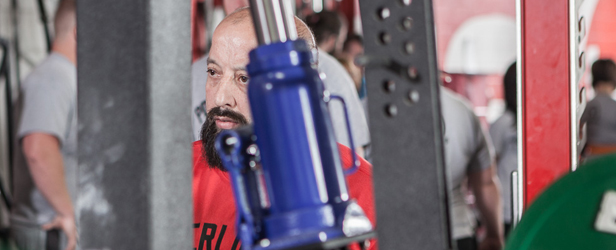
What is a warm-up? This appears to be a question that many powerlifters don’t know the answer to. Well, a warm-up is when you spend a minimal amount of time increasing your body temperature, which could prevent you from a lot of time and agony recovering from an injury later. By performing a minimum of five to ten minutes of cardio in a warm-up prior to strength training, your nervous system becomes more prepared for the task ahead. You could actually just walk. It’s as simple as that. Although this seems easy enough, many lifters seem to avoid it.
Here are some suggestions for how to properly warm up to minimize your chance of injury as well as to maximize your potential in the gym:
- Walk on the treadmill
- Drag the sled
- Push the Prowler®
- Run sprints
If you have excessively tight areas that are inhibiting your form, you'll most likely want to foam or PVC roll them as well. Stretching prior to training isn’t ideal because it can inhibit the stretch reflex, but rolling can loosen the area without decreasing performance. Although this topic is up for debate, I feel that the benefits outweigh the risks.
Here is what I do for my standard rolling routine after my cardiovascular warm-up. This seems to be effective for reducing tightness in the major muscle groups:
PVC roll
- Lower back, shifting to the right and left
- Upper back, shifting to the right and left scapula with the hips up
- Armpits (lat/delt tie in)
- Hamstrings
- Glutes
- Adductors
Foam roll
- Abductors/IT band
If you have shoulder issues, I recommend that you also incorporate internal and external shoulder rotation with bands, elastic tubing, or dumbbells while lying sideways on an incline bench for 2–3 sets of 10–15 reps. You can also do shoulder dislocations with bands or a broomstick. For knee issues, you can warm up with terminal knee extensions (TKE) with bands. For any area that may be an issue for you, there is an exercise that can help to warm the area up and help prevent further issues.
Another example is using internal and external forearm rotation (rotate your hands a quarter turn externally from pronated to neutral with a light dumbbell and then use a heavier dumbbell to rotate from supinated to neutral for reps of 12–15 to help alleviate elbow tendonitis).
You should also perform low reps, gradually increasing warm-up sets specific to each exercise. The point of these sets is to increase blood flow to the muscles that you’re emphasizing without fatiguing them prior to the working sets. Just as lifters often make the mistake of not peaking properly for a meet, they often defeat themselves in the warm-up room by either exhausting themselves by doing too much or not doing enough to properly prepare. Here are some specific examples for the main three lifts:
Squat
As an example, we'll say that your current max is 315 and you chose a reasonable projected max of 340. Your first working set off a high box on the main M2™ Method will be 270 pounds. Your warm-ups should look something like this:
- Bar X 5 (if you feel like you need to warm up with the bar for multiple sets on any exercise in order to work on technique before increasing the weight, you should)
- 135 X 5
- 185 X 3
- 225 X 2
- First working set
Bench
As an example, we'll say that your current max is 225 and you chose a reasonable projected max of 250. Your first working set off a 3-board on the main M2™ Method will be 230 pounds. Your warm-ups should look something like this:
- Bar X 5
- 95 X 5
- 135 X 5
- 185 X 3
- 205 X 1
- First working set
Deadlift
As an example, we'll say that your current max is 350 and you chose a reasonable projected max of 375. Your first working set off four-inch blocks on the main M2™ Method will be 320 pounds. Your warm-ups should look something like this:
- Bar X 5
- 95 X 5
- 135 X 5
- 185 X 3
- 225 X 2
- 275 X 1
- First working set
Essentially, your last warm-up set should be around 75–85 percent of your first working set. I recommend performing the same warm-up sets during training as you would at a meet. In fact, view your working sets as you would your attempts at a meet.
For subsequent accessory exercises, you'll most likely want to perform at least one lighter, low rep warm-up set prior to your heavier, higher rep working sets. For a general example, I always perform a set of five reps with 150 pounds on the lat pull-down before performing higher reps of sets of 8–12 with 160 pounds or more.
There isn't any question that properly warming up will help to reduce your chance of injury and increase longevity in the sport of powerlifting. Thank you for reading and never give up!









